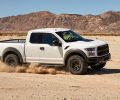DEARBORN, Mich., July 5, 2016 – The all-new Ford F-150 Raptor features six terrain modes designed to handle the most demanding terrains. From off-road rock crawling and desert running to on-road sport mode, Raptor is ready for any type of driving. Here’s a breakdown of each mode.
Normal
For everyday on-road driving duties, normal mode is a perfect balance of excitement, comfort and convenience.
Sport
Mountain passes are no longer just for Mustang, thanks to Raptor sport mode. For spirited on-road driving, sport mode increases throttle response and provides a sportier steering feel – along with quicker shifting. The transmission holds gears longer to keep you in the power band.
Weather
When road conditions are less than ideal, weather mode inspires confidence without compromising driving pleasure. Snow/wet mode automatically engages 4 Auto. AdvanceTrac, throttle response and the shift schedule are optimized for greater confidence in slippery conditions.
Mud/Sand
For tackling trails and other off-road treks, the mud/sand setting is your best friend. 4 High and the electronic locking differential automatically engage for driving over loose or soft ground, and optimized AdvanceTrac settings help Raptor keep its footing. Steering is set to comfort, which makes it easier to navigate along tight trails and over obstacles.
Baja
Baja mode is where Raptor eclipses the competition. Designed for high-speed desert running, Baja mode places the vehicle in 4 High, AdvanceTrac is programmed to the least intrusive settings, and the throttle map is adjusted for more linear power and improved engine response to give the hardcore off-road driver greater control. The transmission has quicker shifts and holds gears longer – keeping the vehicle in its power band.
Rock Crawl
This setting is for intense off-road driving and rock climbing at low speeds. Rock crawl prompts the driver to place the vehicle in 4 Low, the electronic locking differential is automatically engaged and AdvanceTrac is set to the least intrusive settings for optimum rock-climbing ability. Throttle modulation and transmission response are optimized for greater control. Additionally, the front camera allows the driver to see what’s right in front of the truck, and it can be kept on at speeds up to 15 mph.
Along with the individual AdvanceTrac settings tied to drive modes, Raptor continues the Ford Performance tradition of allowing the driver to program the system’s settings to match conditions and skill level. The driver can reduce traction control but keep stability control on with a single press of the electronic stability control button; or, by holding the button for five seconds, the driver can turn AdvanceTrac settings off.



